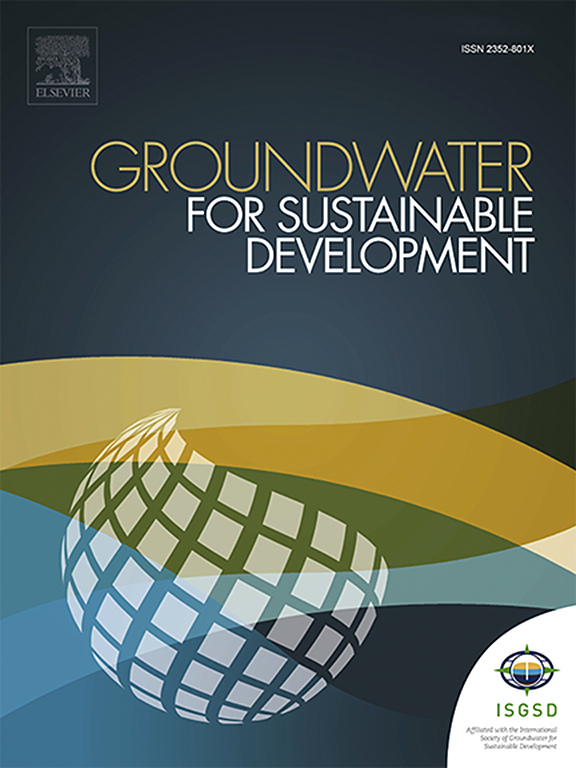Solar and groundwater resources assessment for the installation of photovoltaic pumping systems in the state of Piauí, Brazil
IF 4.9
Q2 ENGINEERING, ENVIRONMENTAL
引用次数: 0
Abstract
The state of Piauí, especially the semi-arid rural areas, has historically suffered from water scarcity. Photovoltaic Pumping Systems (PVPS) have been adopted as an energy proposal to help populations suffering from water scarcity. The aim of this work is to carry out a feasibility study for the installation of PVPS in the state of Piauí, located in northeastern Brazil, by surveying solar and groundwater resources using Geographic Information Systems (GIS). To do this, we used solar irradiation data and data on wells installed in the state of Piauí and aquifers, collected from the online data platforms of the National Meteorological Institute and the Geological Service of Brazil. Next, 10 years of solar irradiation data (2012–2023) and data from aquifer monitoring wells were analyzed both separately and together to determine the most suitable zones for installing PVPS. Visualization of these zones was made possible by using these data to create thematic maps in QGIS software, using the Inverse Distance Weighted interpolation technique. In terms of solar radiation, the state of Piauí has an annual average of 5.54 kWh/m2/day, considered excellent for producing energy using Photovoltaic (PV) systems. The state has a large number of wells, which demonstrates the high dependence on groundwater. The results found in this study indicate that the aquifers in the state of Piauí have an average depth to groundwater of approximately 19.31 m and the average well depth is 116.5 m. The average flow rate found was approximately 5.3 m3/h, and the average specific flow rate for the state was 0.87 m3/h/m, both of which are constant around the average for practically the entire state. These values result in an average Pumping Index of 287 Wh/m3. This shows that the state has great potential for using photovoltaic solar energy to pump water.

巴西Piauí州安装光伏泵系统的太阳能和地下水资源评估
Piauí州,特别是半干旱的农村地区,历史上一直遭受缺水之苦。光伏抽水系统(PVPS)已被采纳为一种能源建议,以帮助遭受水资源短缺的人口。这项工作的目的是通过使用地理信息系统(GIS)调查太阳能和地下水资源,对巴西东北部Piauí州安装pv系统进行可行性研究。为此,我们使用了从巴西国家气象研究所和巴西地质服务的在线数据平台上收集的太阳辐射数据和安装在Piauí州和含水层的井的数据。接下来,对10年(2012-2023年)的太阳辐照数据和含水层监测井的数据进行单独和综合分析,以确定安装PVPS的最合适区域。利用这些数据在QGIS软件中使用逆距离加权插值技术创建专题地图,使这些区域的可视化成为可能。在太阳辐射方面,Piauí的年平均水平为5.54千瓦时/平方米/天,被认为是使用光伏(PV)系统生产能源的绝佳选择。该州有大量的水井,对地下水的依赖程度很高。研究结果表明,Piauí状态下的含水层对地下水的平均深度约为19.31 m,平均井深为116.5 m。发现的平均流量约为5.3 m3/h,该州的平均比流量为0.87 m3/h/m,两者几乎都在整个州的平均值附近恒定。这些值导致平均泵送指数为287 Wh/m3。这表明该州利用光伏太阳能抽水潜力巨大。
本文章由计算机程序翻译,如有差异,请以英文原文为准。
求助全文
约1分钟内获得全文
求助全文
来源期刊

Groundwater for Sustainable Development
Social Sciences-Geography, Planning and Development
CiteScore
11.50
自引率
10.20%
发文量
152
期刊介绍:
Groundwater for Sustainable Development is directed to different stakeholders and professionals, including government and non-governmental organizations, international funding agencies, universities, public water institutions, public health and other public/private sector professionals, and other relevant institutions. It is aimed at professionals, academics and students in the fields of disciplines such as: groundwater and its connection to surface hydrology and environment, soil sciences, engineering, ecology, microbiology, atmospheric sciences, analytical chemistry, hydro-engineering, water technology, environmental ethics, economics, public health, policy, as well as social sciences, legal disciplines, or any other area connected with water issues. The objectives of this journal are to facilitate: • The improvement of effective and sustainable management of water resources across the globe. • The improvement of human access to groundwater resources in adequate quantity and good quality. • The meeting of the increasing demand for drinking and irrigation water needed for food security to contribute to a social and economically sound human development. • The creation of a global inter- and multidisciplinary platform and forum to improve our understanding of groundwater resources and to advocate their effective and sustainable management and protection against contamination. • Interdisciplinary information exchange and to stimulate scientific research in the fields of groundwater related sciences and social and health sciences required to achieve the United Nations Millennium Development Goals for sustainable development.
 求助内容:
求助内容: 应助结果提醒方式:
应助结果提醒方式:


